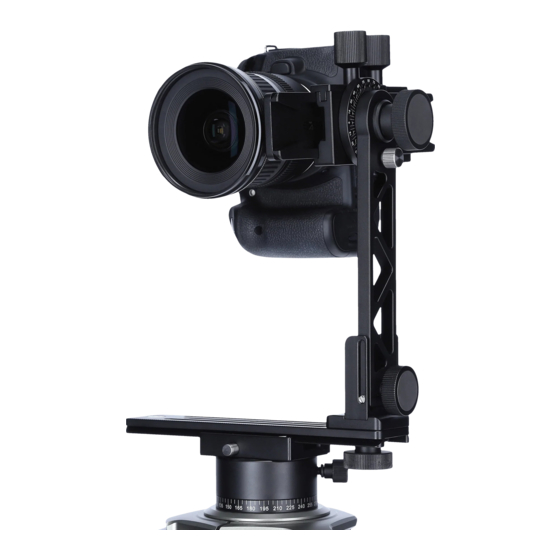
Inhaltszusammenfassung für Rollei 200 Mark II
- Seite 1 Panoramakopf 200 Mark II Panoramic Head 200 Mark II 360° Panorama- Aufnahmen 360° panoramic images User Guide for German and English www.rollei.de...
-
Seite 2: Inhaltsverzeichnis
Inhaltsverzeichnis Einführung . . . . . . . . . . . . . . . . . . . . . . . . . . . . . . . . . . . . . . . . . . . . . . 3 Hauptmerkmale | Verpackungsinhalt 1. -
Seite 3: Hauptmerkmale
Liebe Kundin, lieber Kunde, herzlichen Glückwunsch zum Kauf eines qualitativ hochwertigen Rollei Produktes . Sie haben sich für den Panoramakopf mit guter technischer Ausstattung ent- schieden, der sich besonders einfach bedienen lässt . Bitte lesen Sie alle Hinweise sorgfältig und aufmerksam . Beachten Sie besonders alle Sicherheitshinweise . -
Seite 4: Sicherheitshinweise
1. Sicherheitshinweise Gefahr für Kinder • Halten Sie Kinder von Verpackungsmaterial fern . Es besteht u .a . Erstickungsgefahr! Vorsicht – Sachschäden • Stellen Sie den Panoramakopf auf einen festen, ebenen Untergrund . • Schützen Sie das Gerät vor Nässe, Staub, hohen Temperaturen und direkter Sonneneinstrahlung . -
Seite 5: Produktbeschreibung
2. Produktbeschreibung Der Rollei Panoramakopf 200 Mark II ist ein Mehrzeilen-Panoramakopf . Er hat Gleitteller zum Aufsetzen der Kamera auf der Drehachse des Panoramakopfes, sowie eine Gleitplatte, die sich um die Achse herum nach vorn / nach hinten dreht . Diese Neigung ermöglicht es, die Kamera / das Objektiv vom „Nodal- punkt“... -
Seite 6: Voraussetzungen Für Ein Gutes Panoramabild
3. Voraussetzungen für ein gutes Panoramabild Der Panoramakopf wurde so entwickelt, dass er das Erstellen virtueller Szenen mit dem Computer über verschiedene Sequenzen von Digitalfotos oder digitalisierten Fotos ermöglicht, die von verschiedenen vertikalen Winkeln aus eingefangen werden . Für eine gute Panoramasequenz sind vier Grundvoraussetzungen erforderlich: 1 . -
Seite 7: Den Panoramakopf Aufbauen
4. Den Panoramakopf aufbauen Montieren Sie den Panoramakopf über das 3/8“ Gewinde an der Basisplatte Ihres Stativs . Entfernen Sie nun Knopf „A“ komplett (siehe 1 in Abb . 1) und drehen die Halterung in die vertikale Position (2) . Fixieren Sie die Halterung indem Sie die Schraube in das dafür vorgesehene Gewinde einschrauben . -
Seite 8: Montage Der Kamera
5. Montage der Kamera Abb . 2 Um die obere Schiene des Panorama- kopfes abzunehmen, lösen Sie zunächst die Fixierung „D“ (siehe 1 in Abb . 2) . Ziehen Sie die Schiene bis zum Anschlag heraus und drücken dann den Sicherungsknopf „E“ (2), um sie ganz zu entfernen (3) . - Seite 9 5. Montage der Kamera Abb . 4 In der Schnellwechselplatte befindet sich eine 1/4“-Schraube, die zum Be festigen der Kamera dient (siehe Abb . 4) . Montieren Sie nun die Kamera mit der Befes- tigungsplatte auf der Gleitschiene wie in Abb . 5 dargestellt .
- Seite 10 5. Montage der Kamera Die mit den Platten verbundene Kamera setzen Sie nun mit dem Objektiv nach unten in den Panoramakopf ein (siehe Abb . 6) . Schieben Sie die Gleitschiene über den Widerstand der Sicherheitsverriegelung hinweg in die gewünschte Position und fixieren sie die Schiene durch die seitliche Schraube .
-
Seite 11: Positionierung Des Nodalpunktes
6. Positionierung des Nodalpunktes Um die optische Achse „Q“ der Kamera (siehe Abb . 8) zur Panorama-Drehachse „R“ im Stativ-Mittelpunkt (center) auszurichten, lösen Sie die Schraube der Skalenschiene „S“, bringen die Kamera in die entsprechende Position und fixieren die Schraube wieder . Abb . -
Seite 12: Längspositionierung
6. Positionierung des Nodalpunktes 6.1 Längspositionierung Wählen Sie eine Ebene, die ein nahes Objekt „1” und ein fernes Objekt „2” enthält, die sich aber in der gleichen Sichtausrichtung in vertikaler Richtung befinden (Abb . 10) . 1 . Lösen Sie Knopf „W“ und drehen die Kamera vertikal, so dass die beiden Objekte „1“... -
Seite 13: Seitliche Positionierung
6. Positionierung des Nodalpunktes 6.2 Seitliche Positionierung Wählen Sie eine Ebene, die ein nahes Objekt „1” und ein fernes Objekt „2” in der gleichen Sichtausrichtung in horizontaler Richtung enthält (Abb . 13) . 1 . Lösen Sie die Fixierung der Basis (Lock), um die Kamera um die Panoramaachse herum zu bewegen . -
Seite 14: Anleitung Für Die Kugelpanoramafotografie
7. Anleitung für die Kugelpanoramafotografie Ein besonderes Bild erhält man durch Verknüpfen verschiedener, in unter- schiedlichen horizontalen Winkeln aufgenommener Panoramasequenzen . Zuerst ist die Anzahl der Sequenzen zu definieren, die zum Komplettieren der Kugel notwendig sind . Diese Anzahl hängt von dem verwendeten Linsen- winkel in Verbindung mit der Änderung des Kopfes (Wahl von Schritten von 15°/24°/60°... - Seite 15 7. Anleitung für die Kugelpanoramafotografie Legen Sie die Anzahl der Aufnahmen oder Drehschritte (15°/ 24°/6 0° o der 90°) zwischen jeder Auslösung für die erste Panoramasequenz fest (siehe Tabelle) . Winkel 90° 60° 45° 36° 30° 24° 20° 15° 10° 5° Anz.
-
Seite 16: Entsorgung
8. Entsorgung 8.1 Verpackung Die Produktverpackung besteht aus recyclingfähigen Materialien und kann dem Wertstoffkreislauf zugeführt werden . Entsorgen Sie diese umweltgerecht . 8.2 Gerät Wenn das Gerät einmal ausgedient hat, muss das Gerät entsprechend EG-Richtlinie 2002/96/EG einer geordneten Entsorgung zugeführt werden und darf keinesfalls über den normalen Hausmüll entsorgt werden . -
Seite 17: Spezifikationen
9. Spezifikationen Technische Daten Gewicht 1171 g Material Aluminium Stativkopf-Steuerung 360° Rastschritte Rotation 4x90° | 6x60° | 15x24° | 24x15° Max. Traglast 3 kg Maße (zusammengeklappt) 22 x 14 x 8,7 cm Kameraanschluss 1/4“ Schraubengewinde Stativanschluss 3/8“ Gewinde Lieferumfang Panoramakopf, Transportkoffer Änderungen von Design und technischen Daten bleiben vorbehalten und bedürfen keiner Ankündigung .
















